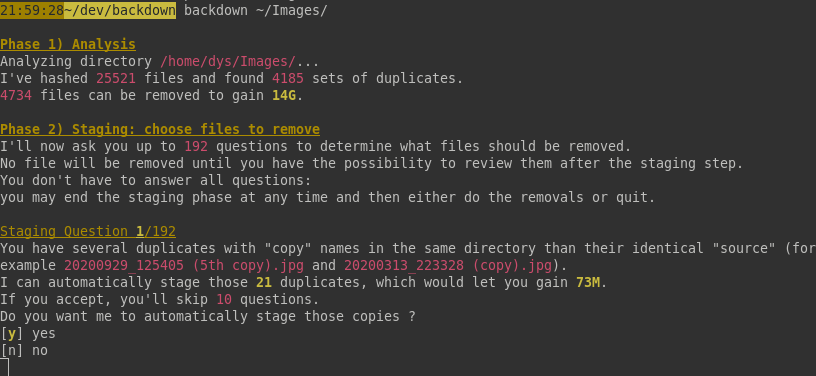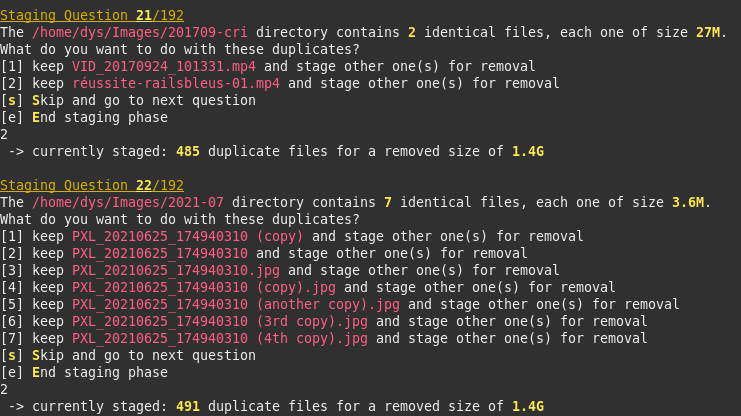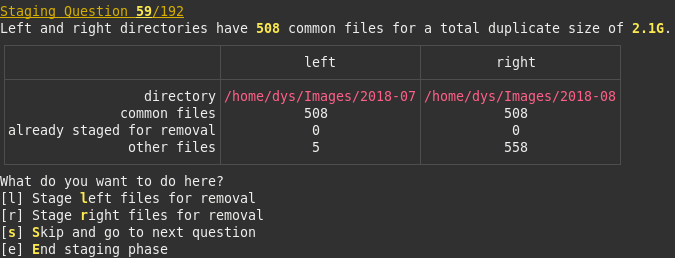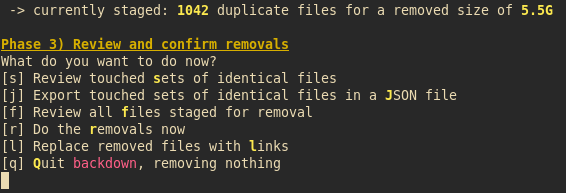11 releases (5 stable)
| 1.1.2 | Sep 10, 2024 |
|---|---|
| 1.1.1 | Jul 1, 2023 |
| 1.1.0 | Dec 5, 2021 |
| 1.0.1 | Nov 17, 2021 |
| 0.0.1 | Aug 21, 2020 |
#240 in Filesystem
260KB
1.5K
SLoC
backdown
Backdown helps you safely and ergonomically remove duplicate files.
Its design is based upon my observation of frequent patterns regarding build-up of duplicates with time, especially images and other media files.
Finding duplicates is easy. Cleaning the disk when there are thousands of them is the hard part. What Backdown brings is the easy way to select and remove the duplicates you don't want to keep.
A Backdown session goes through the following phases:
- Backdown analyzes the directory of your choice and find sets of duplicates (files whose content is exactly the same). Backdown ignores symlinks and files or directories whose name starts with a dot.
- Backdown asks you a few questions depending on the analysis. Nothing is removed at this point: you only stage files for removal. Backdown never lets you stage all items in a set of identical files
- After having maybe looked at the list of staged files, you confirm the removals
- Backdown does the removals on disk
What it looks like
Analysis and first question:

Another kind of question:

Yet another one:

Yet another one:

Review and Confirm:

At this point you may also export the report as JSON, and you may decide to replace each removed file with a link to one of the kept ones.
Installation
From the crates.io repository
You must have the Rust env installed: https://rustup.rs
Run
cargo install --locked backdown
From Source
You must have the Rust env installed: https://rustup.rs
Download this repository then run
cargo install --path .
Precompiled binaries
Unless you're a Rust developer, I recommend you just download the precompiled binaries, as this will save a lot of space on your disk.
Binaries are made available at https://dystroy.org/backdown/download/
Usage
Deduplicate any kind of files
backdown /some/directory
Deduplicate images
backdown -i /some/directory
JSON report
After the staging phase, you may decide to export a report as JSON. This doesn't prevent doing also the removals.
The JSON looks like this:
{
"dup_sets": [
{
"file_len": 1212746,
"files": {
"trav-copy/2006-05 (mai)/HPIM0530.JPG": "remove",
"trav-copy/2006-06 (juin)/HPIM0530 (another copy).JPG": "remove",
"trav-copy/2006-06 (juin)/HPIM0530 (copy).JPG": "remove",
"trav-copy/2006-06 (juin)/HPIM0530.JPG": "keep"
}
},
{
"file_len": 1980628,
"files": {
"trav-copy/2006-03 (mars)/HPIM0608.JPG": "keep",
"trav-copy/2006-05 (mai)/HPIM0608.JPG": "remove",
"trav-copy/2006-06 (juin)/HPIM0608.JPG": "keep"
}
},
{
"file_len": 1124764,
"files": {
"trav-copy/2006-05 (mai)/HPIM0529.JPG": "remove",
"trav-copy/2006-06 (juin)/HPIM0529.JPG": "keep"
}
},
{
"file_len": 1706672,
"files": {
"trav-copy/2006-05 (mai)/test.jpg": "remove",
"trav-copy/2006-06 (juin)/HPIM0598.JPG": "keep"
}
}
],
"len_to_remove": 8450302
}
Advice
- If you launch backdown on a big directory, it may find more duplicates you suspect there are. Don't force yourself to answer all questions at first: if you stage the removals of the first dozen questions you'll gain already a lot and you may do the other ones another day
- Don't launch backdown at the root of your disk because you don't want to try and deal with duplicates in system resources, programs, build artefacts, etc. Launch backdown where you store your images, or your videos or musics
- Backdown isn't designed for dev directories and doesn't respect .gitignore rules
- If you launch backdown in a directory with millions files on a slow disk, you'll have to wait a long time while the content is hashed. Try with a smaller directory first if you have an HDD
- If you're only interested in images, use the -i option
Dependencies
~13–24MB
~364K SLoC